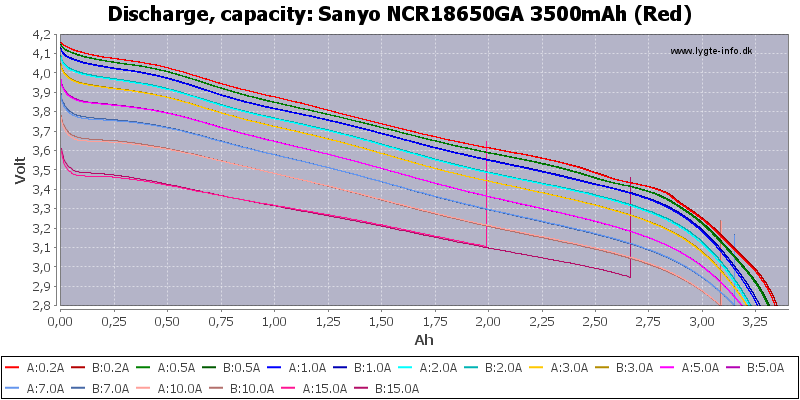Me, I’d actually prefer 4.16V over 4.20V.
Especially if readings are <coff!> “suspect”, a few mV wouldn’t be all that contentious.
Me, I’d actually prefer 4.16V over 4.20V.
Especially if readings are <coff!> “suspect”, a few mV wouldn’t be all that contentious.
Good to hear that . I have got to stop buying chargers. I am getting more than I need.
hmmm…just got it
tested the cells in my TOMO’s for ir
TOMO1
88 fenix arbl23400
78 keepower p1834j 3400
76 Sanyo/Panasonic NCR18650GA 3500mAh protection
68 orbtronic orb3500p
TOMO2
16 Sony VTC6 18650 3000mAh
16 Sony VTC6 18650 3000mAh
16 Sony VTC6 18650 3000mAh
16 Sony VTC6 18650 3000mAh
2nd test
TOMO2
18 Sony VTC6 18650 3000mAh
16 Sony VTC6 18650 3000mAh
24 Sony VTC6 18650 3000mAh
20 Sony VTC6 18650 3000mAh
3rd test
TOMO2
18 Sony VTC6 18650 3000mAh
18 Sony VTC6 18650 3000mAh
16 Sony VTC6 18650 3000mAh
14 Sony VTC6 18650 3000mAh
no, I wasn’t anal about which cell was in which slot.
2nd test
TOMO1
86 fenix arbl23400
72 keepower p1834j 3400
62 Sanyo/Panasonic NCR18650GA 3500mAh protection
64 orbtronic orb3500p
I’m done
Tell me about it. I was agonising over which analysing charger to get, researched all the different types, etc., and ended up pretty much with 1 (or more) of each. :weary:
Just get more batteries, so you can use different chargers simultaneously. And what to do with all those batteries… well get more flashlights. Problem solved.
I guess I have to get out more. With summer here , it gets dark so late that I don’t even use my lights much. And they are like guns , no matter how many you own , you can only use one , maybe two at a time . So many lights and so little time.
Without watching it , I’ll guess he shoots multiple guns at once?
Or just watch me transition from weapon to weapon on the field ![]()
There is no such thing as too many guns. Only too little time and too little ammo.
And you gotta blast “Satisfaction” from yer car-radio. ![]()
Well…actually, you can carry more than one or two weapons at a time. One’s just need to use some scotch tape. :sunglasses: Every once in a while I love to see Ripley kickin’ those Alien asses… :smiling_imp:

I’m not even sure the IMAX style hobby charger will get you much further ahead, unless you are lucky. I have an Opus, several Lii-500, and 2x Zanflare C4, along with an Acucell-6 and Turnigy MAX80W both of which are in the same ‘family’ as the IMAX B6.
I just finished a test of small camera Li-on tests. I get results with a spread of ~ 20% between the 2 hobby chargers. Which one is right? It may be a problem of working with small capacity batteries, tiny wires (high IR), shaky connections, and only able to throttle the discharge down to 100mA. But, at least I’m comparing various cells to one another using the same equipment.
On regular 18650 the hobby chargers are reasonably close to the 4-bay chargers. I seldom use those anymore.
The other 3 4-bay chargers are close enough I don’t worry about the results much. I use what is convenient unless I have a special test to do. The Opus has more options and power, the Zanflare does IR better than the Opus, or is at least more consistent. The IR on the Lii-500 is useless. I’ve have 3, all acted the same, so it seems to be a problem with them in general. The other functions are good.
These are all consumer grade ‘hobby’ chargers. I’d say unless your unit is notably out of whack, you get what you pay for.
I recently got a Zanflare C4 on sale for 17.99 shipped. I don’t have 5 other chargers to compare it to, so for me it is perfect. Perhaps it reads high in capacity, but it will certainly show when the capacity is reduced, and when the IR increases. A man with one watch knows what time it is, while a man with two watches is never sure . . .
As the previous poster said, you likely get what you pay for.
Yeah, even if you know your watch loses 13min/day, you can still guesstimate the “real” time.
Hello, everybody,
as a new owner of a Zanflare C4, I've been busy cycling LSD cells that for the most part have been sitting unused for the last year or so, or employed in low-discharge devices.
HJK mentioned that the C4 would discharge his Eneloops down to 1.05 V, however, I'm seeing cells below the 1 V mark, currently staring at two cells reading 0.92 V, and one has gone down to 0.87 V.
Will the C4 keep discharging as long as the battery is capable of providing the required current of 0.5 A, regardless of the voltage?
Is this voltage realistic or an artifact?
Assuming the data is not garbage, I'm guessing a low discharge voltage does not bode well for the battery's real world usability?
Any other idea or things I should be informed of?
Hello, everybody,
as a new owner of a Zanflare C4, I’ve been busy cycling LSD cells that for the most part have been sitting unused for the last year or so, or employed in low-discharge devices.
HJK mentioned that the C4 would discharge his Eneloops down to 1.05 V, however, I’m seeing cells below the 1 V mark, currently staring at two cells reading 0.92 V, and one has gone down to 0.87 V.
Will the C4 keep discharging as long as the battery is capable of providing the required current of 0.5 A, regardless of the voltage?
Is this voltage realistic or an artifact?
Assuming the data is not garbage, I’m guessing a low discharge voltage does not bode well for the battery’s real world usability?
Any other idea or things I should be informed of?
I’ve tried out the ZanFlare C4 charger’s NOR Test and noticed the following:
the lowest displayed voltage (discharge portion) when using NiMh appears to be 0.87v (exactly the same as what you noticed) - it stops discharging when it hits 0.87v (what I’m not sure is that the 0.87v is probably the voltage under load? or could it be unloaded voltage?)
the lowest displayed voltage (discharge) when using Li-Ion appears to be 2.76v (after the display touches 2.76v, it will stop discharging)
HJK mentioned that the discharge curve is constant, so the voltage displayed should be under load.
Since voltage drops more under load in a cell that has higher internal resistance, I wonder if the explanation is simply that HJK's Eneloop have lower internal resistance than the cells I'm using. His NiMH IR test table shows about 100 milli Ohms, lower than most my NiMH cells, so there's that.
The charger employs fixed discharge cut-off thresholds to avoid damaging cells, maybe HJK's Eneloops could no longer provide the required current before hitting that voltage, I'm not sure.
2.75V is a common cut-off voltage for discharging LiIon, your result seems consistent with HJK's charts.
the lowest displayed voltage (discharge) when using Li-Ion appears to be 2.76v (after the display touches 2.76v, it will stop discharging)
FWIW, I conducted capacity testing on four Panasonic-Sanyo NCR18650GA batteries today using my Zanflare C4 and happened to catch one (a straggler) hitting the same 2.76 v minimum value. One second the value was 2.76v and then the next it was 2.8 v and rising. Missed the other three because they were in the lead.
I received four new NCR18650GA batteries from Orbtonics and tested their 1 kHz internal resistance (IR) with my RM8124A, and capacity with my Zanflare C4 analyzing charger. The IR reading were well-grouped and met the Sanyo NCR18650GA specification of < 38 mΩ. But the C4 capacity readings were too high compared to the typical capacity listed in the NCR18650GA datasheet of 3450 mAh. This caused some misgivings about the C4 and led to additional testing, as shown in the tabulated data below:
Evaluation of New Panasonic-Sanyo NCR18650GA Batteries with| Battery Number |
Capacity1(mAh) | 1 kHz Internal Resistance (mO) | |||
| Zanflare C42 Trial 1 |
MiBoxer C2-40003 |
Zanflare C4 Trial 2 |
LiitoKala Lii-5004 |
||
| 1 | 3627 | 3317 | 3744 | 3361 | 19.4 |
| 2 | 3708 | 3300 | 3768 | 3392 | 18.8 |
| 3 | 3737 | 3322 | 3812 | 3382 | 18.9 |
| 4 | 3674 | 3300 | 3702 | 3325 | 18.8 |
| 1. All three chargers were configured with a 0.5A discharge rate. 2. The minimum Zanflare C4 discharge voltage was about 2.76 V. 3. The minimum MiBoxer C2-4000 discharged voltage was about 2.80 V. 4. The minimum LitoKala Lii-500 discharged voltage was not observed. |
So, I decided to re-test the batteries with my MiBoxer C2-4000 - which provided results somewhat low when compared to minimum capacity listed in the datasheet of 3350 mAh, but seemed more reasonable than the Zanflare C4 results.
The Zanfare C4 got a second trial at evaluating the batteries, but the results were even higher than the first trial.
The final test was with my LiitoKala Lii-500 which provided the most reasonable results. Most of the Lii-500 measurements fell between the minimum capacity of 3350 mAh and typical capacity of 3450 mAh. It also closely resembles the data in the chart below from this HJK post.

CONCLUSIONS:
Wonder how much variation there is in individual units, components over time, and just plain assembly?
I’ve had 3xLii-500 and 2xC4. They are very similar units. I consider my C4 to be more accurate than the Lii-500 using an Opus and 2 different hobby chargers to help compare results. All of mine are more than 2 years old. Maybe that makes a difference…?
The IR of the Lii-500 is completely useless on all units. The C4 IR seems more reliable than my Opus, but they are kinda close. Neither of those is very accurate but they seem to get in the ‘ball park’ and determine good from OK from poor.